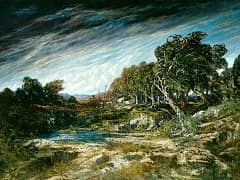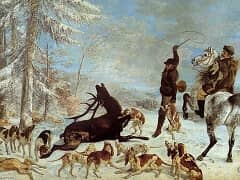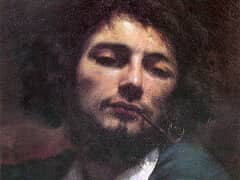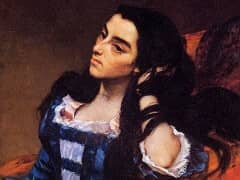The Quarry, 1857 by Gustave Courbet

Shown at the same Salon of 1857 as The Young Ladies on the Banks of the Seine, this was the first of Courbet's paintings on the theme of the hunt. Unlike the Young Ladies, it was favorably received by the critics: huntsmen and their animals were a fixed and traditional theme of painting, not offensive to social or critical sensibilities. Indeed, the motifs of the pair of hunting dogs and the hanging deer can be related to the tradition of the eighteenth-century painters Desportes and Oudry; but there is nothing traditional about the way in which the different elements of the painting have been put together to create an atmosphere of enigma and mystery.
The lively tension between the two dogs, justified in the Metropolitan Museum's painting of the same pair, who compete for possession of a dead hare, is here unmotivated. The French title of the painting, La Curee, is a term that refers to the unleashing of raw appetite, when the hunting dogs are allowed their share of the freshly killed game. But here that moment is long past, and the body of the deer has become an object of beauty and contemplation rather than of violence. The young man dreamily blowing the horn, the traditional sonneur, whose function it is to call the other huntsmen in at the death, is in yet another time frame. Leaning against a tree in a self-enclosed posture, withdrawn and meditative, is the figure of the artist-huntsman. Composed as a self-portrait, the figure is at the actual and metaphorical center of the painting. Courbet the countryman accepts the reality of the hunt as part of what today we would call the food chain; Courbet the painter rejoices in the vitality of animals, in the beauty of their structures and their surfaces; Courbet the man understands the melancholy of their fate. Thus once again the painter constructs a "real allegory" out of his witness to the realities of the life around him. The painting as it was shown at the Salon was lower and narrower than the one we see now, enclosing the figures with greater density.
At the request of the dealer who bought it from him in 1862 and who wanted more "air" in the composition, Courbet attached additional canvas to the left side and to the top of the original. There is a small study for this expanded composition.















